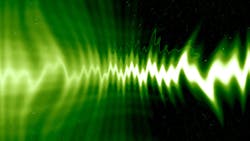This file type includes high-resolution graphics and schematics when applicable.
Terahertz (THz) radiation continues to exhibit its value and versatility in medical applications, such as focused treatment of malignant cells. THz techniques are also showing great promise in the area of materials research at the subwavelength electromagnetic (EM) radiation regions, with resolution on the nanometer scale.
In fact, a researcher from the Tokyo Institute of Technology revealed work on cryogenic THz-emission near-field imaging for close scrutiny of semiconductor devices. The research has provided invaluable information on the spatial distribution of electrons injected from an electrode into a semiconductor channel.
The new approach is a departure from existing aperture- and apertureless-type THz imaging methods. The new THz imaging method performs collection of visualization data by scanning an evanescently coupled THz detector closely across a sample surface, compared to existing methods that work in illumination mode. Based on a GaAs/AlGaAs heterostructure chip, the new approach is simpler and more familiar for most users.
The GaAs chip’s aperture and near-field probe are insulated by a 50-nm-thick silicon-dioxide (SiO2) layer. It has a two-dimensional electron gas-layer heterointerface; this layer features electron mobility of 5000 cm2/V-s. Located 60 nm below the surface of the chip, this two-dimensional gas layer acts as a THz detector. Source and drain electrodes extend to the side surfaces of the chip for electrical connections. Detected THz signals are provided as changes in voltage as a function of THz irradiation by the two-dimensional electron gas detector.
The performance of the THz detector was simulated by means of finite-element (FE) simulation software. Devices were compared with aperture alone and aperture with integrated probe, using the same aperture dimensions in both cases. Testing and simulations revealed that chips without probes failed to detect THz signals, while those with probes successfully detected THz radiation, regardless of wavelength. The spatial resolution of the near-field THz imager was found to be 9 µm. Work continues on this THz near-field microscope component, which could prove invaluable for research at the molecular level on materials and biological subjects.
See “Chip-Based Near-Field Terahertz Microscopy,” IEEE Transactions on Terahertz Science and Technology,” Vol. 6, No. 3, May 2016, p. 356.
About the Author
Jack Browne
Technical Contributor
Jack Browne, Technical Contributor, has worked in technical publishing for over 30 years. He managed the content and production of three technical journals while at the American Institute of Physics, including Medical Physics and the Journal of Vacuum Science & Technology. He has been a Publisher and Editor for Penton Media, started the firm’s Wireless Symposium & Exhibition trade show in 1993, and currently serves as Technical Contributor for that company's Microwaves & RF magazine. Browne, who holds a BS in Mathematics from City College of New York and BA degrees in English and Philosophy from Fordham University, is a member of the IEEE.


